Values-Driven Marketing aligns community and commerce for sustainable, Long-Term Success
With values-driven marketing, business leaders and marketers don’t have to choose between what’s right and what sells.
There’s a popular saying that marketers ruin everything. When things go wrong, it feels that way because marketing influences everything—from what we wear and what we eat to what news we pay attention to and how we vote.
Marketing is all about driving human behaviors, and our behaviors become our reality.
Master marketers have the potential to be master manipulators. Unfortunately for the world we live in, these master manipulators have created a society that celebrates, protects, and rewards many of the worst human behaviors.
But if marketers have the power to do that, we also have the power to swing the pendulum the other way.
Marketers can shape the world, or at least frame our perception of it through shifting behaviors. This means we can use the powerful tools of modern marketing to build brighter futures.
Marketing for good is a choice every business gets the opportunity to make.

For decades, marketing departments have operated on an “ends justify the means” mentality, which has proven to be unsustainable for the people involved.
Much has been written about the Mad Men Era in marketing, but the Web 2.0 personalization and social media revolutions of the past two decades took the misbehaviors of that era to an extreme that even David Ogilvy couldn’t have imagined.
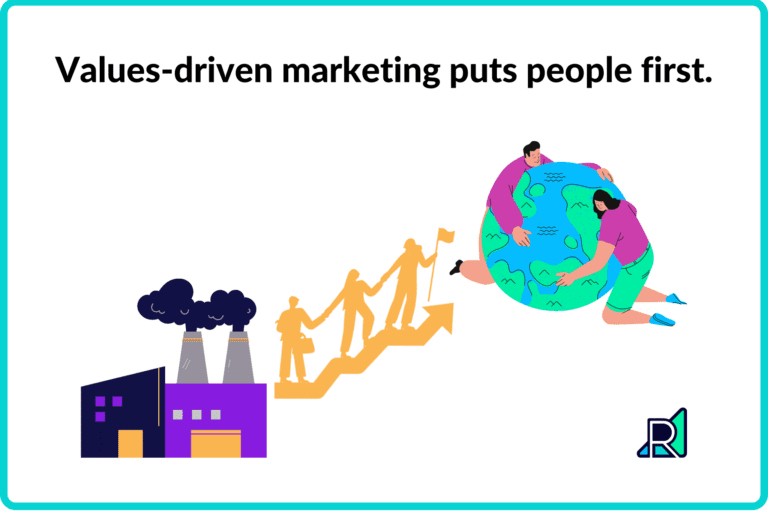
The reality is that business begins and ends with people. The point of a business must be to serve someone; the point of people is never to serve a business.
Therefore, for a business to be sustainable and values-driven, it must prioritize people’s well-being over expediency.
We aren’t here to serve business. Business is meant to serve us. Somewhere along the line, we got it backward. That’s where marketers went wrong.
What if, instead of ruining everything, marketers worked to create a world that prioritized empathy, equity, and accessibility?
What would it look like if we weren’t actively using our words, algorithms, and big data to manipulate people’s thoughts, emotions, and buying patterns for the sole purpose of padding the bottom line?
Since manipulative marketing tactics are so pervasive, unless we are actively working against the status quo that hinders equity, access, and inclusion for all, we are contributing to the problem.
This is not a calling out. This is a call to action.
Lately, more digital marketers are realizing the power they have to impact their communities.
What would shift if all marketers understood the influence we have to create a kinder, more liberated future?
We have to do better as marketers if we’re going to have a better world.
Recent years have seen a rise in digital and integrative marketers working to improve the overall digital landscape.
At Realign Consulting, our mission is to help small and micro businesses learn new ways of doing marketing that align with their values and how they want to impact their communities.
We call it values-driven marketing, a mindset that puts people first (you, your team, and your customers) so everyone benefits.

As we’ve seen over and over and over again, a values-based marketing strategy doesn’t just make you feel awesome—it also helps your business thrive.
If we want things to be different, we have to start doing things differently.
What does that look like?
Choose a topic below to learn more about values-driven marketing and how you can use it to help build a world we all want to live in.
Values-driven marketing positions business in service to people, counter to traditional marketing’s standard approach.
Marketing has long been seen as underhanded, manipulative, and gross—but a necessary evil for businesses who want a fighting chance of success.
However, despite prevailing marketing advice, we don’t have to choose between what’s right and what’s right for our businesses.
Traditional marketing turns people into consumables that feed a company’s bottom line. Values-driven marketing aligns communities with the businesses that serve them for long-term impact.
It’s not easy to choose the path of values-driven marketing. It requires consistently making choices that go against the grain. It requires patience and sustained effort to see results.
Traditional marketing requires that you maintain the status quo of hustling for quick wins.
Values-based marketing is counter-cultural and requires courage as a state of being—the kind of courage that trusts interdependence and human connection for sustainable success.
Values-Driven Marketing
- Believes businesses should serve people
- Creates long-term, sustainable impact
- Requires patience and courage
- Values sustained effort and connection
Traditional Marketing
- Sees people as consumables for businesses
- Creates short-lived, quick wins
- Requires following the status quo
- Values hustle and manipulation
We define values-driven marketing as a people-focused realignment of how business is done.
Marketing is the necessary process of letting our audience know we have the solution they’ve been looking for. That doesn’t change when we add “values-driven” to the term.
And, our marketing methodology is up to us.
As marketers and business leaders, we can choose to be manipulative for short-term gain, which works for a time. Then we have to get up and do it all over again, probably with different prospects since our tactics may have burned our previous customers.
Or, we can choose to…
- Recognize our audience’s humanity (and our own) in our methods of communication
- Invest in a community whose values and worldview align with ours to create long-term, sustainable relationships
- Prioritize nurturing this audience with truly valuable, timely goods and services over bombarding them with brand-focused quick sales
Which of these choices creates a more sustainable and joyful way of doing your work in the world?
Values-driven marketing is bigger than just making money for your business. It’s about sharing a worldview with your community around what you’re doing to create a better world.
Your work could be transforming the face of marketing to help local businesses better support their communities.
It could be helping people take better care of their pets to help them live longer, healthier lives.
Or it could be creating t-shirts that make people laugh and feel like part of something bigger.

The shared worldview is the bond that holds our communities together, and we can define it by the core ways we align with our audiences.
Value-driven marketing requires foundational alignment with the 3 Core.
For marketing to be truly values-driven, the business must have core alignment with three aspects of the people it wishes to serve. Those three aspects are:
- Core Values - Align on deeply ingrained principles that drive actions and decisions.
- Core Beliefs - Align on long and firmly held beliefs that help them define how the world works.
- Core Communities - Align with similar and/or overlapping communities that allow those core values and beliefs to spread holistically.
At Realign Consulting, we call this the 3-Core, and they are the first questions that must be answered in framing a values-based marketing strategy.
And even before we begin to establish the 3-Core Alignment that is the foundation of a values-driven marketing approach, one hard-fast rule must be considered:
Values-driven marketing recognizes marketers' impact on our society and chooses, first and foremost, to do no harm.
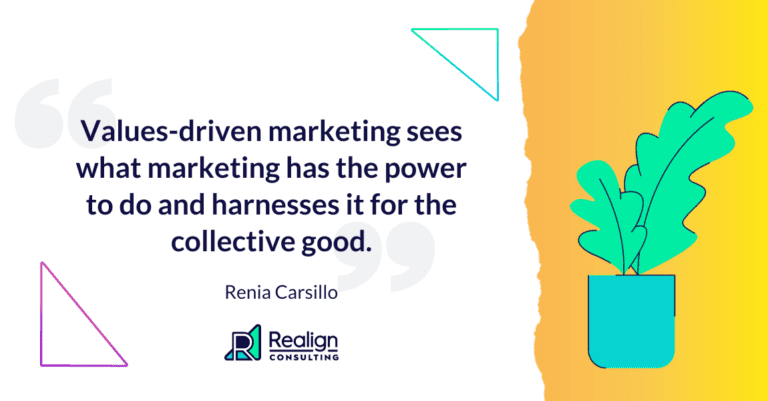
In medicine, doctors are asked to recognize that doing nothing is a better choice than doing harm. I believe we should ask the same of marketers.
We have tremendous power to do good in the world. And, we must sometimes choose not to pick up a tool or tactic that could do more harm than good.
Traditional marketing is fine with FUD marketing (i.e., sewing seeds of fear, uncertainty, and doubt). It’s fine with dishonest tactics like tripwires and clickbait because what ultimately matters is feeding that bottom line.
A values-driven marketing strategy sees what marketing has the power to do and harnesses it for the collective good.
At Realign Consulting, we don’t believe that “First, Do No Harm” is only for medical professionals.
We cannot rely on strategies that harm the communities we strive to serve if we want to leave the world better than how we found it.
Values-Driven Marketing in Action
Perhaps the most rewarding part of our work is seeing our clients reap the benefits of values-driven strategies that positively impact the people around them.
Check out these case studies to see how three companies transformed their marketing and business strategies to provide for their people, impact their communities, and create more time for ease and joy.
Aided by the reminder to do no harm and aligned with humans through the 3-Core, we can then begin to look to using the modern miracles of data in ways that serve our customers and our companies.
Values-driven marketing rethinks how we use personalization and data in our marketing.
Marketing in the smart device age requires data analysis and the hyper-personalization of our marketing that it allows. Yet, personalization is often hyper-manipulative and invasive.
So how do we meet today’s market expectations that our messages and mediums be hyper-personalized while remaining values-aligned?
It’s actually simpler than it sounds.
To use data well, we aim for connection first—not conversion. This allows us to use data tools to authentically build community.
In the digital space, authentically building community looks like…
- Taking time to understand your audience and what they’re struggling with, being sure to talk to them instead of at them
- Being service-minded and customer-centric by continually asking yourself how you can provide value to your clients
- Considering where your audience is coming from when they encounter your social media post, web page, or video so you can provide them with what they need in that moment
- Learning how to make your digital content accessible to your entire audience, regardless of ability or location
- Avoiding bro-marketing tactics by asking, “Would I use this tactic if I were talking to a client face-to-face?”
Whether online or in-person, setting clear boundaries around what you will and will not do—professionally, ethically, etc.—also builds community.
People will know what to expect from you. And when you hold fast to those boundaries, they’ll know they can trust you, too.
With values-driven marketing, you don’t have to choose between what’s right and what’s right for your company. When people feel supported and safe, they are better able to do their work well. Taking care of people means we are taking care of our business.
Boldly communicating your values clarifies who your community is for, saving everybody’s time.
I would like to be clear: values-driven marketing is not about starting arguments on social media or backing a particular political candidate. It’s not about leaving people out.
Values-driven marketing is about giving clear indicators to your customers about what your business stands for and what you will not back down from.
The market has shifted in the past few decades. Now, more than ever, people want to know the kind of company they’re dealing with before they part with their money.
This is especially true if your audience consists of Millennials (born in the 80s and 90s) or younger generations.
The internet has enabled many businesses to reach wider audiences. And the proliferation of online reviews means digital word-of-mouth is even more powerful than ever.

With so many choices at their disposal, consumers have developed more criteria for who they will do business with and who they won’t. As a result of the social upheaval of the past few years, many choose to use their buying power to support companies that are working to build the world they wish to see.
The age-old advice of leaving religion and politics out of business no longer applies. It’s time to help the people who are for you to find you.
In my years in business, I’ve seen this play out in a few ways:
Trades businesses attracting customers by treating people with integrity
As businesses and services started to open back up after the shutdowns in 2020, a few of my local trades businesses decided to be upfront about the precautions they were taking when entering someone’s home. They were concerned about losing customers in our highly conservative area but shared a core value of caring for their people.
Surprisingly (or maybe not), these companies started seeing increased business because people knew exactly what to expect and trusted them to keep everyone safe.
Faith-based businesses attracting customers by being bold about what they stand for
Who in this country, perhaps especially in the Southeast, has not seen a business promote itself as a “Christian business?” Whether you agree with their theology is beside the point—from a marketing standpoint, it clearly works. They understand their target market and make it clear what they stand for. Their audience knows where to find them, and those who disagree have one less option to choose from when deciding where to spend their money. They are calling in those they most wish to serve.
That shifts when the business says something like it’s a “Christian business only doing business with other Christian businesses.” Now, they’re leaving people out. The impact of the call-in lessens, and the company has created an us-versus-them situation. That can be powerful in the short term, but it creates hard feelings that can fester into long-term problems as they grow and perhaps want to call in a more diverse group.
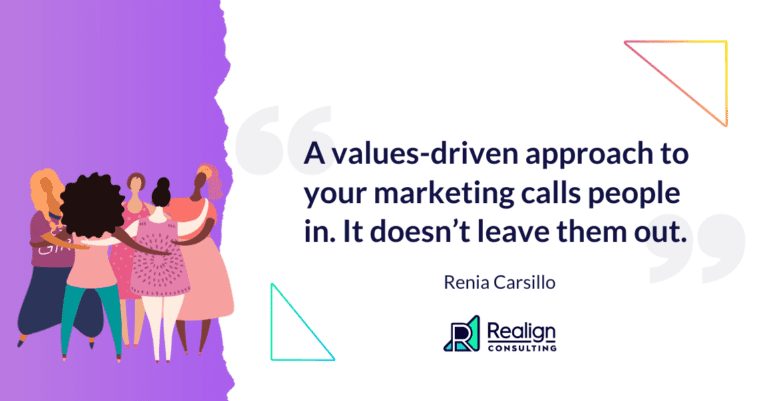
My own business attracting customers by ensuring our actions reflect our stated values
As the face of Realign Consulting, I have not been shy about where we stand on political and social justice issues since our inception (and especially since 2016). This was not done arbitrarily but because doing so aligned with our core values of putting kindness first, prioritizing people over innovation, and developing careful, sustainable leadership.
We have had to walk away from potentially big payouts when the company’s values did not align with ours. But we have also been able to partner with values-aligned companies who make it a joy to come to work and with whom we know we are impacting the world for the better.

Neutrality in business is not an option if empathy and kindness are central to your business values.
Businesses are not neutral because people are not neutral.
Your marketing strategy needs to reach people where they are, whether you’re selling jewelry or a fitness routine.
Knowing what action to take as a brand can be challenging in a hurting world. That’s why it’s critical to deeply understand your 3-Core. Knowing where values, beliefs, and communities align will always point you in the right direction.
When done right, the impact of using the 3-Core is that everyone in your target audience feels like you’re speaking directly to them.
Plus, in times of chaos, we can pause, breathe, and take a hard look at what our stakeholders need from us in that moment.
Maybe it’s a distraction.
Maybe it’s a word of solidarity.
Maybe it’s a way to take action.
When we’re trying to decide how to speak to big groups of people, we can get stuck in our overwhelm.
When we’re trying to stay aligned with our values, we gain clarity that moves us forward.
Clearly communicating your values draws in the people you want to work with. When you remember who you’re serving and why, the question, “What do I do next?” tends to take care of itself.
One special note: As a business, you cannot take a stand on everything and still do your work in the world.
I would like to thank my colleague, Leslie Zane, for pointing out that trying to speak out about every wrong in this world will leave you too burned out to do what you have set out to do.
To find balance, take a stand on things that are core to your values as a company and leave the rest. For those things you still feel strongly about, pass the mic to the experts whose work aligns more closely with those issues.
Make no mistake: As soon as you come out for something, people will pressure you to come out for everything.
But that is exhausting, and it will take away from the primary purpose of your business and your work.
Take the time, right now, to decide the core places where you will not bend as a business.
For us, it’s women’s rights, amplifying marginalized voices, and supporting community-based businesses.
We feel strongly as individuals and as a team about many other issues, but we don’t speak out about them as a business because…
- We don’t have the expertise, so we don’t want to add to the noise that can tend to drown out those who know how to help us all do better.
- It’s not our work to do as a business. (As individuals, it may be a different story.)
Is it possible that you will alienate some people as you go deeper into your values-driven marketing journey?
Yes.
But that gives more space for the people who align with your values and are ready to join you.
The framework for a values-based marketing strategy is flexible and adaptable for the way you do business.
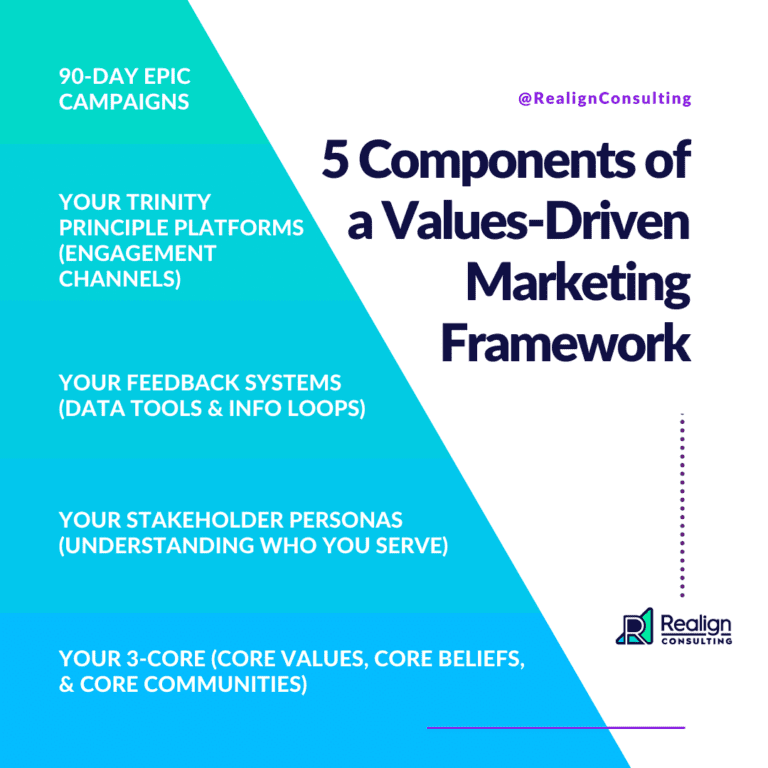
The Values-Driven Marketing Framework consists of five key components…
- The 3-Core - Clear understanding of your core values, core beliefs, and core communities.
- Stakeholder Persona Communities - The people who have a stake in your business. These are customers, employees, investors, and the community your company operates within, at the least, but may include others.
- Your Data/Feedback System - The system you use to measure success and how you collect that data, organize it, and use it to inform decisions about where to go next.
- Your Trinity Principle Channels - Your business's three primary channels to communicate with your stakeholder persona communities.
- 90-Day Epics - The campaign systems and cycles used to spread your message and make money. This is where the tactics we typically associate with the action of marketing live.
We’ll spend more time with the components of the Values-Aligned Marketing strategy in a future piece. For now, know that the most critical piece most companies are missing is getting clear on the 3-Core.
Values-driven marketing is a critical pillar of the Do Better Business™ model.
When I began my small business coaching career, I focused quite a bit on marketing. I even spent an entire season of my podcast talking about strategies to Do Better Digital™ because of the power I believed (and still believe) marketers have to shape the world.
But I’ve realized that true business transformation—the kind that makes a sustainable impact on our companies and communities—touches on multiple areas of the business.
That doesn’t mean our work to develop values-driven marketing strategies has gone to waste. Often, marketing is where we start when onboarding new clients.
In our Strategic Planning Framework, we put Sales & Marketing together as the first pillar of the strategy.
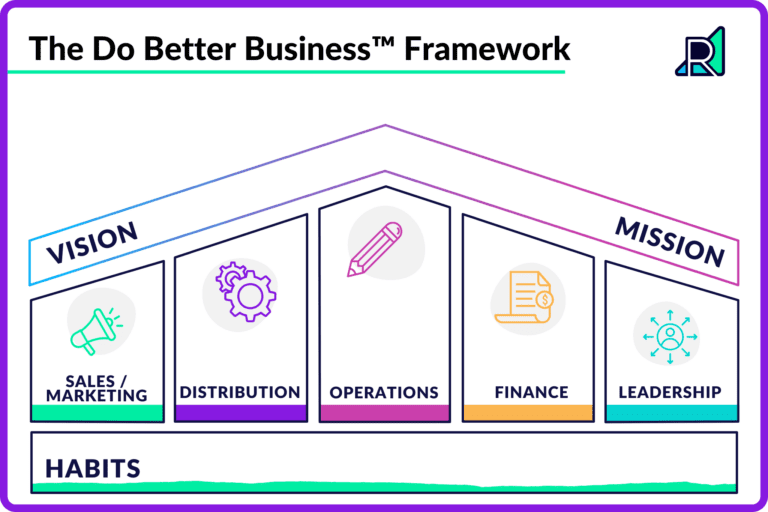
We do that for three reasons:
Sales always comes first.
Without sales, there are no customers. Without customers, there is no business.
Marketing is always required, in some way, to make sales.
A brand is not necessarily needed. Neither is a website, a social media profile, an ad, or even a business name. What is needed is to tell a group of people that you have something they need or want to sell.
At its most fundamental, marketing is matching a need or want with a community. That has to happen before a sale can be made, even if it’s as simple as speaking your offer to another person.
By evaluating the health of a company’s marketing, you can evaluate the health of the company as a whole.
This is why I consider the Marketing Pillar to be a business’ heartbeat. Just like irregularities in our own heartbeat hint at troubles present or looming, so too do irregularities in the marketing cadence of a company.
For example:
- When marketing is absent or lagging, it’s a good indicator that the company is declining.
- When marketing is over-emphasized and/or beating too quickly, it’s a good indicator that the company is overleveraged or headed toward team burnout.
- When marketing is fully integrated into the leadership, product or service delivery, financial structures, and habits of the organization, it’s likely that the company is healthy and sustainable.
We begin our evaluation of a company’s health with its marketing systems not because we believe marketing is the only thing that matters.
We begin with marketing because, in doing so, we can quickly uncover where the most important (and sometimes most urgent) needs are within the organization.
If we view marketing as a heartbeat, we recognize that it should have a strong, steady rhythm, saving the short sprints for when we need them for a specific purpose.
In traditional marketing, we only value short-term wins. But this is not sustainable.
Human beings were made to balance periods of action with periods of rest. Our bodies know this, even when our minds forget. How many of us have suffered the consequences of pushing ourselves too hard for too long?
Values-driven marketing values the cadence of a healthy heartbeat that has the strength to move forward with intention and consistent results.
That’s not to say you can’t use your marketing to move at a heart-racing pace. Sometimes, a big push is needed to prepare for a big event, launch a new product or service, get over a sales slump, or hit an important milestone. But this should not be the standard pace of your strategy.
Laying that sustainable marketing foundation—creating a strong heartbeat—will enable you to make the occasional big push and get the results you’re looking for.
Just remember to return to that steady pace when the sprint is no longer necessary. Otherwise, risk burning out yourself, your team, and even your customers.
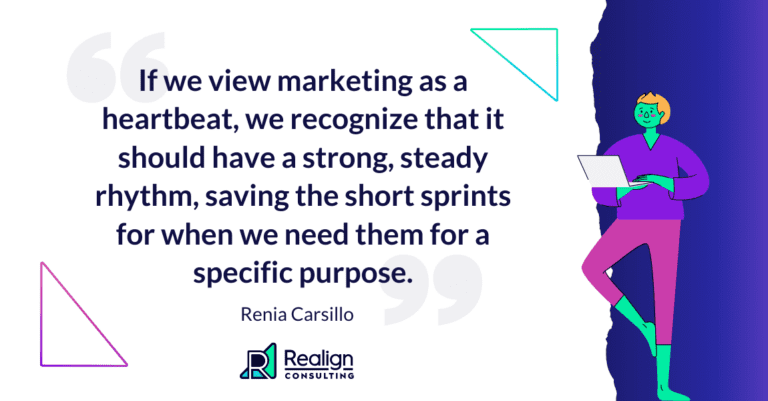
When done well, marketing weaves into almost every aspect of your company, from product development and branding to customer engagement and business growth strategies. It helps ensure you can Do Better Business™ by effectively connecting with your target audience and achieving your goals.
Shifting to values-driven marketing is a journey that starts with a single step.
As companies like Apple and Google finally listen to their customers and start to think more about privacy, companies will find it much more difficult to granularly adjust every tiny aspect of their strategy based on impersonal data points (aka, growth hacking).
This means that a values-driven strategy will become even more important.
It’s difficult to continue to see our audience as numbers on a spreadsheet when that spreadsheet is no longer reliable—if it ever was.
To thrive, small and micro businesses, in particular, will need to build community with those who share their worldview.
We will need to see the human beyond the screen and build a connection based on shared values and desires.
So, where do we start?
The first step of a values-driven marketing strategy is to clearly define our values.
One of the exercises we complete with our Business Strategy Retreat clients is having them list their top company values. And it’s not as easy as it sounds.
If you haven’t done this already, schedule some time this week to sit with these questions:

- What values do you embody (or hope to embody) as a company?
- What values are so critical to who you are that you are willing to sacrifice potential profit to stay true to them?
Then, start taking action to align what you do with what you believe.
If you’ve been using manipulative tactics like tripwires or FUD marketing, decide what steps you will take to do things differently.
And remember, this is a marathon, not a sprint. Realigning our marketing strategy doesn’t happen all at once, but one step at a time is still progress.
Maybe we can start by…
- Deciding what’s good enough for a click-through rate (CTR) and stop overtesting,
- Removing the tripwire and accepting that we’re going to make a little less money on that particular product or service, or
- Making shifts toward a community-building business model so we can do a little less hard selling when that community takes off.
Let’s choose right now to see the human first, to align with values as the first goal of our marketing strategy, not just selling things.
And, as you evolve as a leader and a company, expect your values to evolve as well.
As Maya Angelou so famously said, “Do the best you can until you know better. Then, when you know better, do better.”
What baby step will you take today to make the world you wish to see?
Write it down. Post it where you can see it. Then, let’s get to work.
Go Deeper
Partner With a Strategic Planning Consultant to Values-Align Your Business
Are you ready to align your business to impact your community as only you can? See if working with a values-driven strategic planning consultant is right for you.

